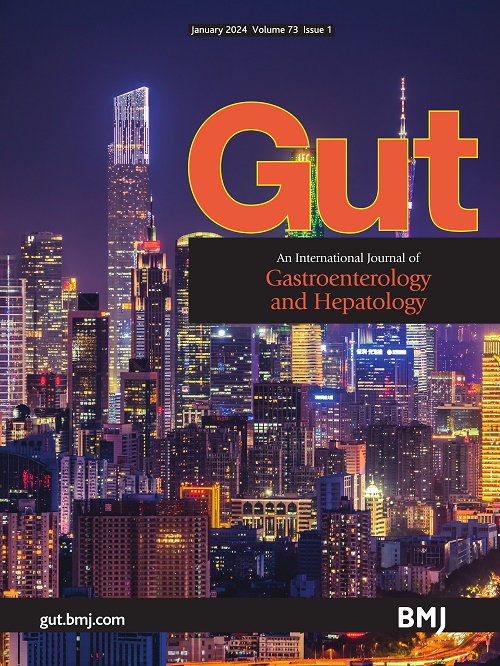Single-cell multimodal analysis reveals the dynamic immunopathogenesis of HBV-ACLF progression
IF 25.8
1区 医学
Q1 GASTROENTEROLOGY & HEPATOLOGY
引用次数: 0
Abstract
Background Acute-on-chronic liver failure (ACLF) is a life-threatening syndrome involving dysfunction of multiple immune cell types. Objective This study aimed to comprehensively depict the dynamic trajectory of immune responses throughout the disease course of HBV-related ACLF (HBV-ACLF). Design Single-cell RNA sequencing and single-cell proteomics were performed on the peripheral blood mononuclear cells of 45 samples from 17 patients who were hospitalised (progressive/stable/recovering course of HBV-ACLF, 6/5/6) and 15 control subjects (liver cirrhosis, chronic hepatitis B and healthy controls, 5/5/5). Functional and mechanistic experiments were validated in vivo and in vitro. Results Single-cell multiomics analysis revealed specific changes in the peripheral immune response in ACLF. VCAN+CD14+-monocytes with activated interferon-stimulated genes and enhanced inflammatory functions, stimulated by HBV relapse and expanded in ACLF-1, fuelling early inflammatory storm. The subsequent apoptotic hepatocytes predominantly induce hyperinflammatory C-X-C motif chemokine receptor 2 (CXCR2)+-neutrophils and CD163+-monocytes, enriching in patients with progressive ACLF and serving as significant markers of disease deterioration. Cytotoxic T-cells were functionally impaired and significantly decreased in progressive patients. CXCR2+-neutrophils exhibited immunosuppressive activity and induced the exhaustion of cytotoxic T-cells. Pharmacological inhibition of CXCR2 significantly reduced neutrophils infiltration, restored cytotoxic T-cells and showed therapeutic effect in ACLF mice. Six immune cellular modules (CMs) were identified for patient stratification, with CM2 and CM6 showing strong predictive value for disease outcomes, and CM3 indicating a potential early therapeutic window. Conclusion Our longitudinal multiomics study revealed the dynamic evolution of the immune response in HBV-ACLF and characterised diverse immune patterns for the future precise management and therapeutic intervention. Data are available in a public, open access repository. Data are available upon reasonable request. All data relevant to the study are included in the article or uploaded as supplementary information. All data relevant to the study are included in the article or uploaded as supplementary information. The raw data for scRNA-seq and bulk RNA-seq used in this study have been deposited into the Genome Sequence Archive (单细胞多模态分析揭示了HBV-ACLF进展的动态免疫发病机制
急性慢性肝衰竭(ACLF)是一种危及生命的综合征,涉及多种免疫细胞类型的功能障碍。目的本研究旨在全面描述hbv相关性ACLF (HBV-ACLF)在整个病程中免疫反应的动态轨迹。对17例住院患者(HBV-ACLF进展/稳定/恢复期,6/5/6)和15例对照组(肝硬化、慢性乙型肝炎和健康对照,5/5/5)的45份外周血单个核细胞样本进行单细胞RNA测序和单细胞蛋白质组学分析。在体内和体外进行了功能和机制实验。结果单细胞多组学分析揭示了ACLF外周免疫应答的特异性变化。干扰素刺激基因激活的VCAN+CD14+单核细胞和增强的炎症功能,在HBV复发的刺激下在ACLF-1中扩大,促进早期炎症风暴。随后的肝细胞凋亡主要诱导高炎性C-X-C基序趋化因子受体2 (CXCR2)+-中性粒细胞和CD163+-单核细胞,在进行性ACLF患者中富集,并作为疾病恶化的重要标志。细胞毒性t细胞功能受损,在进行性患者中显著减少。CXCR2+-中性粒细胞表现出免疫抑制活性,诱导细胞毒性t细胞衰竭。药理抑制CXCR2可显著减少中性粒细胞浸润,恢复细胞毒性t细胞,对ACLF小鼠有治疗作用。确定了6种免疫细胞模块(CMs)用于患者分层,其中CM2和CM6对疾病结局具有很强的预测价值,CM3表明潜在的早期治疗窗口。结论我们的纵向多组学研究揭示了HBV-ACLF免疫反应的动态演变,并为未来的精确管理和治疗干预提供了多种免疫模式。数据可以在一个公共的、开放访问的存储库中获得。如有合理要求,可提供资料。所有与研究相关的数据都包含在文章中或作为补充信息上传。所有与研究相关的数据都包含在文章中或作为补充信息上传。本研究中使用的scRNA-seq和大宗RNA-seq的原始数据已存入Genome Sequence Archive(登录号:HRA007042, HRA007057和HRA008336)。
本文章由计算机程序翻译,如有差异,请以英文原文为准。
求助全文
约1分钟内获得全文
求助全文
来源期刊

Gut
医学-胃肠肝病学
CiteScore
45.70
自引率
2.40%
发文量
284
审稿时长
1.5 months
期刊介绍:
Gut is a renowned international journal specializing in gastroenterology and hepatology, known for its high-quality clinical research covering the alimentary tract, liver, biliary tree, and pancreas. It offers authoritative and current coverage across all aspects of gastroenterology and hepatology, featuring articles on emerging disease mechanisms and innovative diagnostic and therapeutic approaches authored by leading experts.
As the flagship journal of BMJ's gastroenterology portfolio, Gut is accompanied by two companion journals: Frontline Gastroenterology, focusing on education and practice-oriented papers, and BMJ Open Gastroenterology for open access original research.
 求助内容:
求助内容: 应助结果提醒方式:
应助结果提醒方式:


